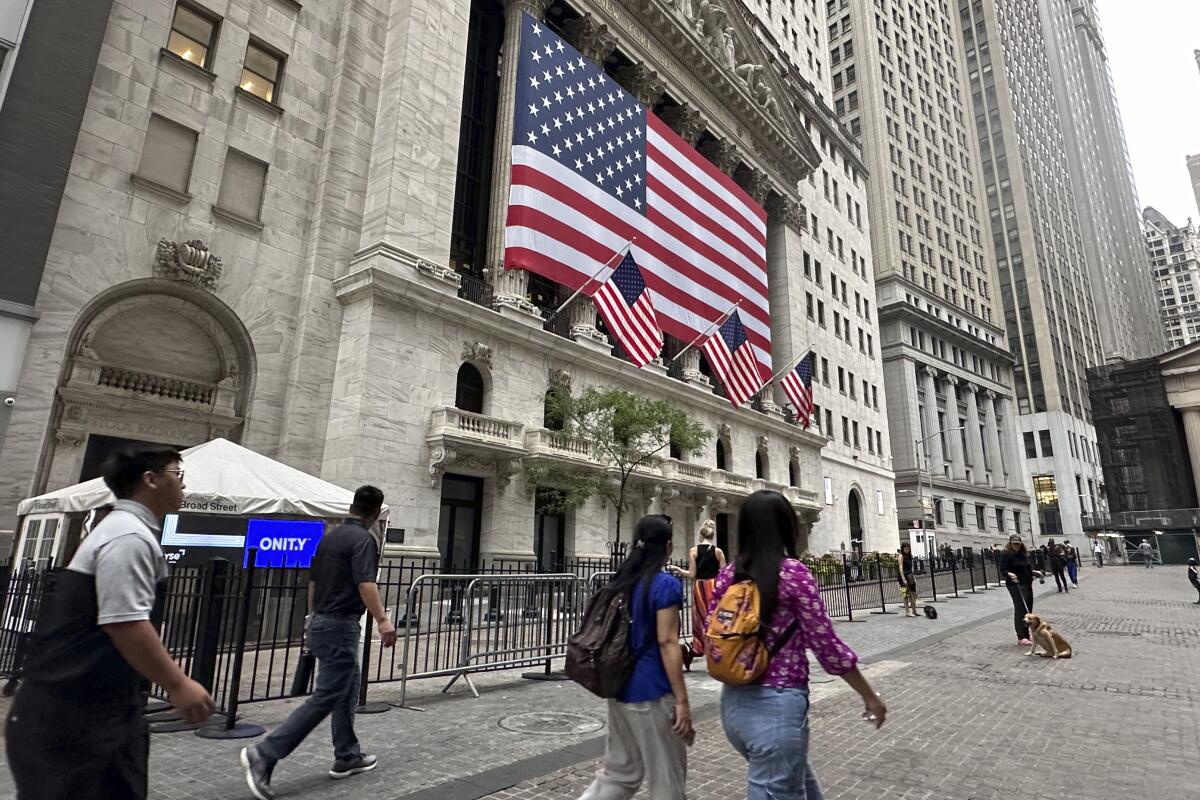A washout on Wall Street sends stocks, big and small, lower

NEW YORK — A widespread washout for U.S. stocks dragged Wall Street lower on Thursday.
The S&P 500 dropped 0.8% to pull further from its all-time high set on Tuesday. The Dow Jones industrial average tumbled 533 points, or 1.3%, from its own record set a day before, while the Nasdaq composite sank 0.7%.
As they did the day before, when the Nasdaq tumbled to its worst loss since 2022, several Big Tech stocks led the market lower. Drops of 2% for Apple, 2.2% for Amazon and 0.7% for Microsoft were three of the heaviest weights on the S&P 500.
Unlike much of the last week, though, Thursday’s losses hit many corners of the market. Smaller stocks, which had been cranking higher after badly lagging behind their larger rivals, fell more than the rest of the market. The Russell 2000 index lost 1.8% after jumping more than 1% in five of the last six days.
The majority of stocks within the S&P 500 also fell after giving up gains from earlier in the day. The sharpest loss came from Domino’s Pizza, which dropped 13.6% despite topping analysts’ expectations for profit in the spring.
The pizza chain temporarily suspended its forecast for how many stores it will open globally over the long term. Although that’s probably due to reasons beyond the company’s control, analysts said it could frustrate investors.
Darden Restaurants, the company behind Olive Garden, LongHorn Steakhouse and other chains, sank 3%. It said it would buy the Chuy’s Tex-Mex chain in an all-cash deal valuing it at $605 million. Chuy’s stock jumped 47.8%.
Stocks of chip companies stabilized a bit after tumbling a day earlier amid worries about potentially worsening tensions with China. U.S.-traded shares of Taiwan Semiconductor Manufacturing rose 0.4% after the industry giant reported stronger profit for the latest quarter than analysts expected. It bounced back from its loss of 8% the prior day, but only after swerving between gains and losses.
Nvidia rose 2.9% after likewise flipping between gains and losses through the day. It stretched its gain for the year to nearly 145%.
Earlier this year, a climb for Nvidia and some of the other handful of stocks that came to be known as the “Magnificent Seven” may have been enough to prop up the rest of the market.
That’s what they did for a while, after all, as their stock prices rocketed amid a frenzy around artificial intelligence technology, even as other stocks struggled under the weight of higher interest rates and slowing economic growth.
Because the S&P 500 and other indexes give more weight to stocks of bigger size, and because the Magnificent Seven stocks had swelled into Goliaths, gains for Big Tech could drive up the market almost by themselves.
But a shift had gotten underway on Wall Street over the last week. Instead of piling into Big Tech, which critics have called too pricey, investors moved toward smaller stocks, companies whose profits are closely tied to the economy’s strength and other areas that have been unloved for a while.
The momentum kicked into high gear after an encouraging report on inflation raised expectations for the Federal Reserve to begin easing interest rates in September. Lower rates and a solid U.S. economy could mean bigger benefits for smaller companies than for Big Tech giants, which rose almost regardless of such factors.
The market saw a similar turn in momentum around the end of last year, but it didn’t last. Strategists at UBS led by Maxwell Grinacoff say they need to see several milestones “for this rotation to be real and sustainable.”
Among them, they say the job market and economic growth would need to be modestly sustained over the next few months and inflation would have to continue to cool.
In the bond market, Treasury yields rose after some mixed data on the economy.
One report said more workers applied for unemployment benefits last week than economists expected. That could be a signal of a softening job market, though the number remains low compared with history.
A separate report said manufacturing in the mid-Atlantic region is growing much better than economists thought.
The yield on the 10-year Treasury rose to 4.19% from 4.16% late Wednesday.
Wall Street is hoping the economy can remain in a “Goldilocks” state — not so hot that there’s upward pressure on inflation but not so cold that it slides into a recession.
Besides hopes for coming cuts to the Fed’s main interest rate, which has been sitting at its highest level in more than two decades, expectations for stronger corporate profit growth have also helped drive stocks.
D.R. Horton jumped 10.1% for the largest gain in the S&P 500 after the home builder reported stronger profit and revenue for the spring than analysts expected. Other home builders also rallied, including a 2.5% rise for PulteGroup and a 2.1% climb for Lennar.
All told, the S&P 500 fell 43.68 points to 5,544.59. The Dow dropped 533.06 points to 40,665.02, and the Nasdaq sank 125.70 points to 17,871.22.
In stock markets abroad, European indexes were mixed after the European Central Bank held its main interest rate steady. Asian indexes were also mixed.
Choe writes for the Associated Press.
More to Read
Inside the business of entertainment
The Wide Shot brings you news, analysis and insights on everything from streaming wars to production — and what it all means for the future.
You may occasionally receive promotional content from the Los Angeles Times.










